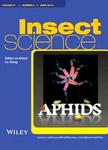Does Bt maize expressing CrylAc protein have adverse effects on the parasitoid Macrocentrus cingulum (Hymenoptera: Braconidae)?
Does Bt maize expressing CrylAc protein have adverse effects on the parasitoid Macrocentrus cingulum (Hymenoptera: Braconidae)?作者机构:State Key Laboratory for Biology of Plant Diseases and Insect Pests MOA - CABI Joint Laboratory for Bio-safety Institute of Plant Protection Chinese Academy of Agricultural Science Beijing China Department of Entomology China Agriculture University Beijing China
出 版 物:《Insect Science》 (昆虫科学(英文版))
年 卷 期:2017年第24卷第4期
页 面:599-612页
核心收录:
学科分类:0710[理学-生物学] 0830[工学-环境科学与工程(可授工学、理学、农学学位)] 09[农学] 0904[农学-植物保护] 0901[农学-作物学] 090401[农学-植物病理学] 090402[农学-农业昆虫与害虫防治] 0713[理学-生态学]
基 金:Genetically Modified Organisms Breeding Major Projects [2014ZX08011-003] Special Fund for Agro-scientific Research in the Public Interest
主 题:CrylAc toxin ELISA environmental risk assessment non-target effects parasitoids prey/host quality-mediated effects
摘 要:The potential effects of insect-resistant, genetically engineered (GE) crops on non-target organisms, especially on predators and parasitoids, must be evaluated before their commercial cultivation. The effects of GE maize that produces CrylAc toxin on the parasitoid Macrocentrus cingulum were assessed by direct bioassay and indirect bioassay. In the indirect bioassay, parasitism rate, cocoon weight and the number of M. cingu- lure progeny produced per host were significantly reduced when M. cingulum-parasitized CrylAc-susceptible Ostriniafurnacalis were fed a diet containing purified CrylAc; how- ever, life-table parameters of M. cingulum were not adversely affected when the same assay was performed with Cry 1Ac-resistant (9. furnacalis. These results indicated that the detrimental effects detected with a CrylAc-susceptible host were mediated by poor host quality. In a direct bioassay, no difference in life-table parameters were detected when M. cingulum adults were directly fed a 20% honey solution with or without CrylAc; however, survival and longevity were significantly reduced when M. cingulum adults were fed a honey solution containing potassium arsenate, which was used as a positive control. The stability and bioactivity of CrylAc toxin in the food sources and CrylAc toxin uptake by the host insect and parasitoid were confirmed by enzyme-linked immunosorbent assay and sensitive-insect bioassays. Our results demonstrate that M. cingulum is not sensitive to CrylAc toxin at concentrations exceeding those encountered in Bacillus thuringiensis maize fields. This study also demonstrates the power of using resistant hosts when assess- ing the risk of genetically modified plants on non-target organisms and will be useful for assessing other non-target impacts.



